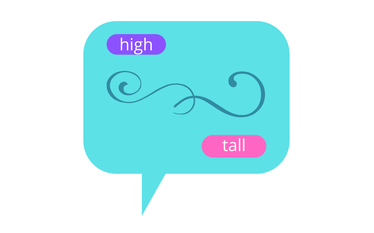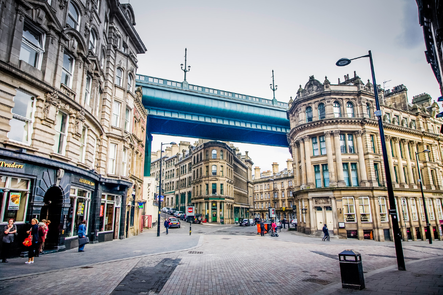|
Do you know when to use "high"? How about "tall"? In this lesson, you will learn what the difference is between these two adjectives and how to use them accurately. There are two short exercises for you to practise at the end of the lesson. * Sometimes these adjectives can be used interchangeably. HIGH 🔸 We use "high" to measure the distance from the bottom to the top. 🔸 We use it to describe: mountains, statues, towers, walls, fence, buildings, etc. 🔸 We use "high" to describe things that are a long way above the ground. 🔸 Buildings can be "high" or "tall". (Both are correct.) Examples:
❗️ Don't use "high" to talk about people. Use "tall". TALL 🔸 We use "tall" when a person, building, tree, etc. has a greater than average height. 🔸 We use it to describe: people, trees, plants, grass, buildings and parts of buildings. 🔸 We use "tall" to describe things that are high and thin. 🔸 Buildings can be "high" or "tall". (Both are correct.) Examples:
❗️ Don't use "tall" to talk about mountains or walls. Use "high". Exercise 1 Is it high or is it tall?
Answers: 1; tall; 2. high/tall; 3. high; 4. tall; 5. tall; 6. tall. 7. high; 8. high/tall; 9. tall; 10. tall; Exercise 2 Complete the sentences with high or tall. Use the comparative or superlative form of each adjective where necessary.
Answers: 1. high; 2. tall; 3. high; 4. tall; 5. highest/tallest; 6. highest; 7. taller; 8. tall; 9. high; 10. tallest; Other lessons: Confusing words: Come vs. Go Confusing words: Bring vs. Take Confusing words in English: Famous vs. Popular Confusing words in English: Fast, Quick or Quickly Confusing words in English: Slow vs. Slowly Please LIKE and SHARE with friends! DO YOU WANT TO IMPROVE YOUR ENGLISH SKILLS?Our lessons are engaging and encourage students to speak more on a specific topic.
Students learn and practise new vocabulary, and improve grammar as well. You will receive feedback on your mistakes and advice how to improve. Subscribe to our newsletter for any future lessons on this blog.
|
Subscribe to our newsletter for any future lessons on this blog.
You will be notified via email.
In this lesson, we give you common expressions to talk about your higher education, educational background, student life and university. Read the expressions below and complete them to make them true for you. This lesson will also be suitable for students preparing for the IELTS speaking test.
Note: You don't have to remember every single expression. Learn the ones that you relate to.
If you are taking the IELTS exam or any other speaking test where you might be asked to talk about your education and it will be better for you to extend your answers.
Example: I majored in Financial Management, but that wasn't a course I was interested in. I decided to study something different, so I sent applications to UK universities and registered for a course at Newcastle University.
EXPRESSIONS TO TALK ABOUT YOUR UNIVERSITY AND HIGHER EDUCATION
VOCABULARY
TASK:
(Leave a comment below.)
Other lessons:
City Life – Going out
Cities – Talk about your area
Business English: How to Talk about Your Job Responsibilities
Lessons with English collocations:
English Lesson: Collocations for Leisure
English Lesson: Collocations for Success
English Lesson: Collocations for Making Decisions
Click below to read some of our IELTS related lessons:
IELTS Speaking Test: Home and Living in the City
IELTS Speaking Test: How to Concentrate at Work
Causes and Effects of Migration from Rural Areas to Cities
Please LIKE and SHARE with friends!
Note: You don't have to remember every single expression. Learn the ones that you relate to.
If you are taking the IELTS exam or any other speaking test where you might be asked to talk about your education and it will be better for you to extend your answers.
Example: I majored in Financial Management, but that wasn't a course I was interested in. I decided to study something different, so I sent applications to UK universities and registered for a course at Newcastle University.
EXPRESSIONS TO TALK ABOUT YOUR UNIVERSITY AND HIGHER EDUCATION
- I went to college in another city.
- I didn't go to college in another city.
- I wanted to study at .................... (university: Newcastle University)
- My major is .................... (course: Linguistics with Chinese)
- I majored in .................... (course: Business Accounting and Finance)
- I majored in Business Management.
- I majored in economics at the University of Bristol.
- I'm studying in .................... (place: city, country)
- I'm a third year media student at Newcastle University.
- I'm studying part time. | I'm studying full time.
- I'm a part-time student. | I'm a full-time student.
- I'm studying an undergraduate course part time. | I'm studying an undergraduate course full time.
- My first degree is in International Marketing. (= Bachelor's degree)
- I did English as my undergraduate degree, but I really wanted to change my career path because I didn't want to be an English teacher, so therefore I applied for a master's degree in something completely different.
- I'm a postgraduate student at .................... (university)
- I'm doing a PhD in Journalism and Public Relations.
- Before I enter the lecture, I have to scan my student card on the reader, so that the university can keep a record of my attendance.
- My attendance on campus is quite flexible.
- At my university, we have seminars on .................... (subject: Public Relations)
- I particularly enjoy the Public Relations seminars because they're a lot more practical than other modules.
- My course has a great variety of modules.
- .................... is probably my favourite module on the course. (subject: Marketing)
- 'What modules do you do?' -- 'I do PR and Marketing, so it's a really good mix of practical and theoretical. PR is more practical.'
- I'm taking a course in marketing.
- I'm taking German and economics next semester.
- I didn't major in this field.
- You can get a job in a field you didn't study.
- For many jobs you need to have a university degree.
- For many jobs you need to have a college degree.
- Students can take advantage of distance learning and study online at their own pace.
- The location of the university is fantastic. It's right in the centre of town which means you can go anywhere you want fairly quickly. You're five minutes away from everything.
- Newcastle is a great student city.
- The annual tuition fee is ....................
- My tuition fee is not fixed for the duration of my studies.
- The scholarship pays the tuition fees but students still need to find money for meals, books and accommodation.
- The university offers a huge variety of postgraduate courses.
- I graduated from .................... in .................... (university; year)
VOCABULARY
- distance learning (also long-distance learning) - when the student is not present at university
- tuition fee - the money that you pay to be taught, especially in a college or university
- a university degree | a college degree
- first degree - an academic qualification given by a university or college, for example a BA or BSc, that is given to somebody who does not already have a degree in that subject
- bachelor's degree - the first degree that you get when you study at a university. Bachelor's degrees include Bachelor of Arts (BA) and Bachelor of Science (BSc)
- an undergraduate degree (a Bachelor's degree)
- a postgraduate degree (a Master's degree)
- a PhD - the abbreviation for ‘Doctor of Philosophy’ (a university degree of a very high level that is given to somebody who has done research in a particular subject)
- do a PhD | have a PhD
TASK:
- What did you study at university? | What are you studying at university?
- What do you think about your course?
- What is your student experience?
(Leave a comment below.)
Other lessons:
City Life – Going out
Cities – Talk about your area
Business English: How to Talk about Your Job Responsibilities
Lessons with English collocations:
English Lesson: Collocations for Leisure
English Lesson: Collocations for Success
English Lesson: Collocations for Making Decisions
Click below to read some of our IELTS related lessons:
IELTS Speaking Test: Home and Living in the City
IELTS Speaking Test: How to Concentrate at Work
Causes and Effects of Migration from Rural Areas to Cities
Please LIKE and SHARE with friends!
DO YOU WANT TO IMPROVE YOUR ENGLISH SKILLS?
You can have 1-on-1 speaking classes on Skype or you can choose to prepare for the IELTS speaking test. Click below to find out more information about each course.
Subscribe to our newsletter for any future lessons on this blog.
You will be notified via email.
In this lesson, you will learn 10 common idioms with DAY that are often used in conversations.
ONE DAY | SOME DAY
When you talk about some time in the future.
Examples:
DAY AND NIGHT
All the time
Examples:
DAY IN, DAY OUT
When you talk about something that you do every day for a long period of time.
Examples:
Note: Something that you do every day for a long time, especially in a way that is boring.
FROM ONE DAY TO THE NEXT
If something changes from one day to the next, it changes suddenly.
Examples:
AT THE END OF THE DAY (informal)
After you have taken everything into consideration.
Examples:
THE OTHER DAY
At some point in the recent past, a few days ago.
Examples:
IN THIS DAY AND AGE
At the present time, nowadays, these days, in the modern world
Examples:
MAKE SOMEONE'S DAY
To make someone very happy
Examples:
CALL IT A DAY (informal)
If you 'call it a day', you stop an activity for the rest of the day. (e.g. work, study)
Examples:
(AS) CLEAR AS DAY | (AS) PLAIN AS DAY
When something is easy to see or understand.
Examples:
Other lessons:
Phrases with HAVE and TAKE
10 Ways to Say that Something is Bad
10 Ways to Say that Something is Good
6 Ways to Say that Something is Cheap
6 Ways to Say that Something is Expensive
Commonly Used Phrases in Spoken English
Please LIKE and SHARE with friends!
ONE DAY | SOME DAY
When you talk about some time in the future.
Examples:
- I'd like to visit Sydney one day.
- One day I'd like to have my own apartment and live there by myself.
- I lived in Germany for two years and I'll definitely go back there some day.
DAY AND NIGHT
All the time
Examples:
- You can hear the traffic noise day and night.
- The baby has been crying day and night.
- The store is open day and night so you can go any time.
- Every member of the team has worked day and night on the new product launch.
DAY IN, DAY OUT
When you talk about something that you do every day for a long period of time.
Examples:
- I have to do the same boring tasks day in, day out.
- I used to drink coffee day in, day out, but I rarely do now.
- I don't like eating the same food day in, day out.
Note: Something that you do every day for a long time, especially in a way that is boring.
FROM ONE DAY TO THE NEXT
If something changes from one day to the next, it changes suddenly.
Examples:
- In my job, I never know what to expect from one day to the next.
- I really don't like it when my boss tells me to complete tasks from one day to the next.
- I never know what my schedule will be. My shift may change from one day to the next.
AT THE END OF THE DAY (informal)
After you have taken everything into consideration.
Examples:
- At the end of the day you will decide for yourself where you want to live.
- You may ask other people for advice, but at the end of the day, it's up to you.
- I got a great job offer in China, but at the end of the day, I decided to stay in my country.
THE OTHER DAY
At some point in the recent past, a few days ago.
Examples:
- We met for a coffee the other day.
- I met an old friend of mine in the mall the other day.
- I forgot to tell you that I got an email from him the other day. He's coming back from the States in the summer.
IN THIS DAY AND AGE
At the present time, nowadays, these days, in the modern world
Examples:
- Healthy eating should be one of your main priorities in this day and age.
- 'Food prices keep going up and up.' -- 'What do you expect in this day and age?'
- The Internet is the most important source of information in this day and age.
MAKE SOMEONE'S DAY
To make someone very happy
Examples:
- Just seeing the smile on her face made my day.
- Thank you all for the birthday wishes. You really made my day.
- Getting compliments on my appearance always makes my day.
CALL IT A DAY (informal)
If you 'call it a day', you stop an activity for the rest of the day. (e.g. work, study)
Examples:
- I can't call it a day. I need to work a couple more hours.
- I have one last question for you and then we can call it a day.
- Can we call it a day and continue next time? (= to stop a lesson or something else)
(AS) CLEAR AS DAY | (AS) PLAIN AS DAY
When something is easy to see or understand.
Examples:
- It's as clear as day who's going to win the competition.
- It's plain as day that they like each other. (= it's obvious)
- Their furniture is easy to assemble and the instructions are as clear as day, so don't worry.
Other lessons:
Phrases with HAVE and TAKE
10 Ways to Say that Something is Bad
10 Ways to Say that Something is Good
6 Ways to Say that Something is Cheap
6 Ways to Say that Something is Expensive
Commonly Used Phrases in Spoken English
Please LIKE and SHARE with friends!
DO YOU WANT TO IMPROVE YOUR ENGLISH SKILLS?
Our lessons are engaging and encourage students to speak more on a specific topic.
Students learn and practise new vocabulary, and improve grammar as well.
You will receive feedback on your mistakes and advice how to improve.
Students learn and practise new vocabulary, and improve grammar as well.
You will receive feedback on your mistakes and advice how to improve.
In this lesson, you will learn 10 common idioms with TIME that are often used in conversations.
AT TIMES
Sometimes, but not often
Examples:
AT ONE TIME
When you talk about something related to a time in the past, but not now.
Examples:
ALL THE TIME | THE WHOLE TIME
When something happens continuously or very often.
Examples:
When something happens during the whole of a particular period of time.
AHEAD OF TIME
Earlier than expected
Examples:
Note: 'Ahead of time' is mainly used in American English.
BEHIND TIME
Later than expected
Examples:
BEFORE MY TIME
When something happened before you were born or before you started living somewhere.
Examples:
BEHIND THE TIMES
If someone or something is behind the times, they are old-fashioned.
Examples:
TAKE TIME OUT
To take a break from something; To spend time away from studying or working
Examples:
IN NEXT TO NO TIME | IN NO TIME
When you do something extremely quickly.
Examples:
FOR THE TIME BEING
For a limited period or at this time
Examples:
Other lessons:
6 Ways to Say that Something is Cheap
6 Ways to Say that Something is Expensive
Common Phrases in Spoken English (Part 1)
Common Phrases in Spoken English (Part 2)
Discourse Markers for IELTS Speaking and Everyday English
Please LIKE and SHARE with friends!
AT TIMES
Sometimes, but not often
Examples:
- Being a parent can be hard at times. (= sometimes)
- At times even A students lose their motivation. (= students who always get A's for their work)
- You're likely to feel stressed at times, especially in a job like this.
- I love hanging out with friends, but at times, I just need to be by myself. (= alone)
AT ONE TIME
When you talk about something related to a time in the past, but not now.
Examples:
- At one time, I wanted to study law, but now I'm not so sure.
- At one time, my sister wanted to be a pharmacist, but it's a bit late now.
- I was a teacher at one time, but then I decided to become a flight attendant, so I could travel the world for a few years before settling down. (settle down - to live a quieter way of life by getting married or living permanently in one place)
ALL THE TIME | THE WHOLE TIME
When something happens continuously or very often.
Examples:
- My mum leaves the TV on all the time.
- Stop complaining all the time - it's really annoying!
- When my friend was sick, I was worried about her the whole time.
- I keep practising speaking English and I'm improving all the time.
When something happens during the whole of a particular period of time.
- I was trying to find my library card in my wallet while it had been in my handbag all the time.
AHEAD OF TIME
Earlier than expected
Examples:
- I always prepare my lessons ahead of time. (= before teaching)
- Sometimes our classes finish ahead of time. (= earlier than expected)
- My flight landed fifty minutes ahead of time, so I had to wait for my mum to pick me up.
Note: 'Ahead of time' is mainly used in American English.
BEHIND TIME
Later than expected
Examples:
- The train left twenty minutes behind time. (= after it should have left)
- The plane took off thirty minutes behind time. (= after it should have taken off)
BEFORE MY TIME
When something happened before you were born or before you started living somewhere.
Examples:
- This type of music was popular before my time.
- They say he was a great singer but that was before my time.
- I don't remember the fall of the Berlin Wall - it was before my time.
BEHIND THE TIMES
If someone or something is behind the times, they are old-fashioned.
Examples:
- My parents are a bit behind the times. (= old-fashioned in ideas and habits)
- My grandparents are really behind the times - they don't even have a colour television.
- When my friend got a new smartphone, mine was a bit behind the times. (mine = my phone)
- I know my camera is behind the times but I can't afford a new one.
TAKE TIME OUT
To take a break from something; To spend time away from studying or working
Examples:
- You look tired. Why don't you take some time out? (= take a break)
- I took time out after quitting my job to think about the next chapter of my life.
- Some young adults prefer to take time out between high school and university.
- I'm taking time out from my job to travel and live abroad for a year.
IN NEXT TO NO TIME | IN NO TIME
When you do something extremely quickly.
Examples:
- We fixed the problem in next to no time.
- The holiday will be over in next to no time.
- The test was so easy, I was done in next to no time.
- The test was so easy, I was done in no time.
FOR THE TIME BEING
For a limited period or at this time
Examples:
- I'm quite happy at school for the time being. (= at the moment, but not permanently)
- They've just moved to London and they're renting a flat for the time being.
- They went on holiday and we're looking after their cat for the time being. (= at the moment, but this will change)
Other lessons:
6 Ways to Say that Something is Cheap
6 Ways to Say that Something is Expensive
Common Phrases in Spoken English (Part 1)
Common Phrases in Spoken English (Part 2)
Discourse Markers for IELTS Speaking and Everyday English
Please LIKE and SHARE with friends!
DO YOU WANT TO PRACTISE SPEAKING ENGLISH IN A GROUP?
Practise speaking English with other learners of English for 7 days.
Record a voice message of up to 10 minutes and share it with others for feedback.
Interaction is encouraged, so you can learn from others.
COME AND JOIN US!
Record a voice message of up to 10 minutes and share it with others for feedback.
Interaction is encouraged, so you can learn from others.
COME AND JOIN US!
In this lesson, you will learn 10 common idioms with MIND that are often used in conversations.
ON YOUR MIND
If someone or something is on your mind, you keep thinking or worrying about it.
Examples:
COME TO MIND | SPRING TO MIND
If something comes to mind or springs to mind, it is the first thing you think of.
Examples:
Note: Do not say that something ‘comes to your mind’ or ‘springs to your mind’. Say that it comes to mind or springs to mind.
SLIP YOUR MIND
If something slips your mind, you forget it.
Examples:
CROSS SOMEONE'S MIND
If something crosses your mind, you think about it for a short time.
Examples:
KEEP (SOMETHING) IN MIND | BEAR (SOMETHING) IN MIND
When you remember something, especially something that will be important in the future.
Examples:
MAKE UP YOUR MIND
When something makes you stop thinking or worrying about something.
Examples:
CHANGE YOUR MIND | CHANGE SOMEONE'S MIND
It is used when you change a decision you have made or an opinion that you had.
Examples:
Note: You may change your mind or someone else may change your mind.
TAKE YOUR MIND OFF SOMETHING | TAKE SOMEONE'S MIND OFF SOMETHING
When something makes you stop thinking or worrying about something.
Examples:
AT THE BACK OF YOUR MIND | IN THE BACK OF YOUR MIND
If a thought is at the back of your mind, you are aware of it, though it is not the main thing you are thinking about.
Examples:
SOMEONE'S MIND GOES BLANK (informal)
If you mind goes blank, you suddenly cannot remember something.
Examples:
Other lessons:
English Conversation: Saying Goodbye
Common Phrases in Spoken English (Part 1)
Common Phrases in Spoken English (Part 2)
Spoken English: How to Agree and Show Interest
Discourse Markers for IELTS Speaking and Everyday English
Please LIKE and SHARE with friends!
ON YOUR MIND
If someone or something is on your mind, you keep thinking or worrying about it.
Examples:
- You've been on my mind all day. (= I've been thinking about you.)
- It's difficult to study if you have something on your mind.
- I can't bother my mum right now - she's got a lot on her mind.
- Sorry I forgot to call you last night. I've got a lot on my mind these days. (= a lot of problems to worry about)
COME TO MIND | SPRING TO MIND
If something comes to mind or springs to mind, it is the first thing you think of.
Examples:
- He asked for my opinion, but nothing came to mind.
- I was thinking about who might be suitable for this position, and your name came to mind.
- When talking about famous businessmen, three names immediately spring to mind.
Note: Do not say that something ‘comes to your mind’ or ‘springs to your mind’. Say that it comes to mind or springs to mind.
SLIP YOUR MIND
If something slips your mind, you forget it.
Examples:
- 'I told you about the event two weeks ago. How could you forget something so important?' -- 'I'm sorry, it just slipped my mind.'
- I'm sorry I didn't call you back earlier. It completely slipped my mind.
- I sometimes have so much to do that the most important tasks slip my mind.
- Her birthday completely slipped my mind.
CROSS SOMEONE'S MIND
If something crosses your mind, you think about it for a short time.
Examples:
- The idea crossed my mind as you were speaking.
- It never crossed my mind that he might be married. (= I never thought about that.)
- What was the first thing that crossed your mind when you won the competition?
KEEP (SOMETHING) IN MIND | BEAR (SOMETHING) IN MIND
When you remember something, especially something that will be important in the future.
Examples:
- Thanks for your advice – I’ll keep it in mind.
- Keep that in mind when you make your decision.
- Bear in mind that the price doesn't include flights.
- Don't spend all your money at once. Keep in mind that it has to last you all week.
MAKE UP YOUR MIND
When something makes you stop thinking or worrying about something.
Examples:
- I like them both - I can't make up my mind. (= I can't decide which one to buy.)
- I can't make up my mind which universities to apply to.
- I can't make up my mind what to study.
CHANGE YOUR MIND | CHANGE SOMEONE'S MIND
It is used when you change a decision you have made or an opinion that you had.
Examples:
- Nothing will make me change my mind.
- We've changed our minds about selling the car.
- We changed our minds and decided to go camping instead of skiing.
- He's already decided to live abroad. It would be impossible to change his mind.
- She's still very young. She might change her mind about what she wants to do in the future.
Note: You may change your mind or someone else may change your mind.
TAKE YOUR MIND OFF SOMETHING | TAKE SOMEONE'S MIND OFF SOMETHING
When something makes you stop thinking or worrying about something.
Examples:
- Going back to work helped take my mind off things.
- I often go for a walk to take my mind off my studies.
- Why don't you go out for a few hours? It will take your mind off exams.
- I was upset about my exam results, but I went out with some friends to take my mind off it.
AT THE BACK OF YOUR MIND | IN THE BACK OF YOUR MIND
If a thought is at the back of your mind, you are aware of it, though it is not the main thing you are thinking about.
Examples:
- It's been at the back of my mind to call you for several days now.
- At the back of my mind, I knew she was lying.
SOMEONE'S MIND GOES BLANK (informal)
If you mind goes blank, you suddenly cannot remember something.
Examples:
- When he asked me for my number, my mind went completely blank.
- Even though I studied hard, my mind went blank on the exam day.
Other lessons:
English Conversation: Saying Goodbye
Common Phrases in Spoken English (Part 1)
Common Phrases in Spoken English (Part 2)
Spoken English: How to Agree and Show Interest
Discourse Markers for IELTS Speaking and Everyday English
Please LIKE and SHARE with friends!
DO YOU WANT TO PRACTISE SPEAKING ENGLISH IN A GROUP?
Practise speaking English with other learners of English for 7 days.
Record a voice message of up to 10 minutes and share it with others for feedback.
Interaction is encouraged, so you can learn from others.
COME AND JOIN US!
Record a voice message of up to 10 minutes and share it with others for feedback.
Interaction is encouraged, so you can learn from others.
COME AND JOIN US!
We usually use the adjective 'cheap' to say that something costs less money than we expected.
Cheap can suggest that something is poor quality. To avoid the negative connotation of this word, we can use other adjectives when we talk about products and services that cost little money.
In this lesson, you will learn how to use 6 different adjectives that can replace the word 'cheap'.
Let's look at the example sentences below.
LOW (meaning: not costing a lot of money)
We use 'low' to talk about prices, rents, and fees.
REASONABLE (meaning: not too expensive)
When a price is 'reasonable', it seems fair – neither cheap nor expensive.
INEXPENSIVE (rather formal) (meaning: cheap; doesn't cost a lot of money)
When we say that something is 'inexpensive', we actually mean it's good value for its price.
AFFORDABLE (meaning: not expensive)
When something is 'affordable', it is cheap enough for most people to be able to buy.
COMPETITIVE (meaning: not expensive to make, buy, or use)
Competitive prices and rates are as low as those charged by other shops and companies.
ECONOMICAL (meaning: cheap because you do not need to use a lot of money)
We use 'economical' when something doesn't cost much money.
Other lessons:
10 Ways to Say that Something is Bad
10 Ways to Say that Something is Good
6 Ways to Say that Something is Expensive
Common Phrases in Spoken English (Part 1)
Common Phrases in Spoken English (Part 2)
Please LIKE and SHARE with friends!
Cheap can suggest that something is poor quality. To avoid the negative connotation of this word, we can use other adjectives when we talk about products and services that cost little money.
In this lesson, you will learn how to use 6 different adjectives that can replace the word 'cheap'.
Let's look at the example sentences below.
LOW (meaning: not costing a lot of money)
We use 'low' to talk about prices, rents, and fees.
- Walmart is able to keep prices low.
- January is always a good month to travel because prices are low.
- A great way to save money on airline tickets is to use a low-cost carrier.
- Some airlines offer lower fares and make travelling easier.
REASONABLE (meaning: not too expensive)
When a price is 'reasonable', it seems fair – neither cheap nor expensive.
- I would definitely go to that restaurant again. They offer good food at a reasonable price.
- Vegetables are very reasonable at this time of year. (= not too expensive)
- They sell quality products at reasonable prices.
INEXPENSIVE (rather formal) (meaning: cheap; doesn't cost a lot of money)
When we say that something is 'inexpensive', we actually mean it's good value for its price.
- It's a simple, inexpensive meal.
- Can you recommend a relatively inexpensive hotel?
- I'd rather have an inexpensive cup of coffee. (= prefer to have)
- What is the best store where I can find inexpensive furniture?
AFFORDABLE (meaning: not expensive)
When something is 'affordable', it is cheap enough for most people to be able to buy.
- The restaurant is fancy, yet very affordable.
- I love shopping for new clothes but I try to save money at the same time -- that's why I always shop online at affordable prices.
- Public transport fares in Singapore are more affordable than those in Tokyo, Beijing, Hong Kong and Taipei.
- Many governments are struggling with providing high quality affordable housing.
COMPETITIVE (meaning: not expensive to make, buy, or use)
Competitive prices and rates are as low as those charged by other shops and companies.
- The store sells a large range of kitchen appliances at very competitive prices.
- Their exchange rates are very competitive if you compare them with other banks.
ECONOMICAL (meaning: cheap because you do not need to use a lot of money)
We use 'economical' when something doesn't cost much money.
- The big packet is more economical than the small one -- it's only 80 cents more.
- It's more economical to buy a bike rather than renting one every time.
- It wasn't very economical to get my washing machine repaired, so I bought a new one.
Other lessons:
10 Ways to Say that Something is Bad
10 Ways to Say that Something is Good
6 Ways to Say that Something is Expensive
Common Phrases in Spoken English (Part 1)
Common Phrases in Spoken English (Part 2)
Please LIKE and SHARE with friends!
DO YOU WANT TO PRACTISE SPEAKING ENGLISH IN A GROUP?
Practise speaking English with other learners of English for 7 days.
Record a voice message of up to 10 minutes and share it with others for feedback.
Interaction is encouraged, so you can learn from others.
COME AND JOIN US!
Record a voice message of up to 10 minutes and share it with others for feedback.
Interaction is encouraged, so you can learn from others.
COME AND JOIN US!
We usually use the adjective 'expensive' to say that something costs a lot of money. We can also use other adjectives with the same meaning.
In this lesson, you will learn how to use 6 different adjectives that can replace the word 'expensive', which can make you sound like a better English speaker.
Let's look at the example sentences below.
HIGH (meaning: too expensive and not worth the price)
We use 'high' to talk about a rent, fee, price, tax, etc.
Note: We can also use high to talk wage, salary, pay, income.
PRICEY (informal) (meaning: expensive)
We use 'pricey' when something costs more than we want to pay for it.
OVERPRICED (meaning: too expensive and not worth the price)
Something that is overpriced is more expensive than it should be.
COSTLY (meaning: costing a lot of money)
When you say that something is costly, you mean that the price is more than you want to pay.
EXORBITANT (meaning: much too expensive; much more than is reasonable)
We use 'exorbitant' to talk about an amount of money that is much higher than it should be.
ASTRONOMICAL (meaning: extremely high)
We use 'astronomical' to talk about prices, costs, rates, and fees that are extremely high.
Other lessons:
English Lesson: 5 Types of Lifestyle
10 Ways to Say that Something is Bad
10 Ways to Say that Something is Good
English collocations:
English Lesson: Collocations for Leisure
English Lesson: Collocations for Rural Life
English Lesson: Collocations for Urban Life
English Lesson: Collocations for Saving Money
Please LIKE and SHARE with friends!
In this lesson, you will learn how to use 6 different adjectives that can replace the word 'expensive', which can make you sound like a better English speaker.
Let's look at the example sentences below.
HIGH (meaning: too expensive and not worth the price)
We use 'high' to talk about a rent, fee, price, tax, etc.
- Rent prices in major cities around the world are higher than previous years.
- Housing shortage and rental demand are the main reasons for high rent prices.
- The cost of accommodation is extremely high in some neighbourhoods.
- Some countries like the UK and Germany have a progressive income tax, which means that the more money you earn, the higher taxes you pay.
- Overseas students entering Dutch universities pay higher tuition fees than EU nationals.
- The cost of living in Denmark is high even by European standards.
- Salaries in Denmark are relatively high.
Note: We can also use high to talk wage, salary, pay, income.
PRICEY (informal) (meaning: expensive)
We use 'pricey' when something costs more than we want to pay for it.
- Everything on the menu is very pricey.
- The food there is a bit pricey but it's absolutely delicious.
- Eating out and utility bills in Denmark are especially pricey.
OVERPRICED (meaning: too expensive and not worth the price)
Something that is overpriced is more expensive than it should be.
- I think the food there is a bit overpriced.
- The shop sells overpriced clothes.
- The shoes are nice, but they're really overpriced.
COSTLY (meaning: costing a lot of money)
When you say that something is costly, you mean that the price is more than you want to pay.
- Buying a new car can be costly, so why not look for a used one?
- We gave up buying a new fridge because it was too costly.
- It's extremely costly to purchase all the necessary equipment for the business.
EXORBITANT (meaning: much too expensive; much more than is reasonable)
We use 'exorbitant' to talk about an amount of money that is much higher than it should be.
- Some dentists charge exorbitant fees.
- The company charges exorbitant prices for everything.
- I decided to cancel my credit card because of the exorbitant interest rate.
ASTRONOMICAL (meaning: extremely high)
We use 'astronomical' to talk about prices, costs, rates, and fees that are extremely high.
- The house was sold for an astronomical price.
- Tuition fees at private universities are astronomical.
- I can't take out a loan because the interest rate is astronomical.
Other lessons:
English Lesson: 5 Types of Lifestyle
10 Ways to Say that Something is Bad
10 Ways to Say that Something is Good
English collocations:
English Lesson: Collocations for Leisure
English Lesson: Collocations for Rural Life
English Lesson: Collocations for Urban Life
English Lesson: Collocations for Saving Money
Please LIKE and SHARE with friends!
DO YOU WANT TO PRACTISE SPEAKING ENGLISH IN A GROUP?
Practise speaking English with other learners of English for 7 days.
Record a voice message of up to 10 minutes and share it with others for feedback.
Interaction is encouraged, so you can learn from others.
COME AND JOIN US!
Record a voice message of up to 10 minutes and share it with others for feedback.
Interaction is encouraged, so you can learn from others.
COME AND JOIN US!
Author
Your English Success Today is happy to share some free lessons with you. We want to help you improve your English language skills through this blog. Please feel free to leave a comment and share this blog with your friends and colleagues who are also learning English. We hope you enjoy our lessons.
No copying
You must not modify, adapt, copy, store, transfer or circulate the contents of this website under any other branding or as part of any other product. You may not print out material for any commercial purpose or resale.
Copyright © Your English Success Today
You must not modify, adapt, copy, store, transfer or circulate the contents of this website under any other branding or as part of any other product. You may not print out material for any commercial purpose or resale.
Copyright © Your English Success Today
NEW!
IELTS
SPEAKING
PART 2
2019 & 2020
Exam Topics
practice
&
feedback
IELTS Speaking Exam Preparation Course
Thanks for visiting the blog! :)
Lots of images on Facebook!
Fast reply to emails: 1 - 8 hrs
Archives
October 2020
June 2020
February 2020
August 2019
June 2019
March 2019
February 2019
January 2019
December 2018
November 2018
October 2018
September 2018
August 2018
July 2018
June 2018
May 2018
April 2018
March 2018
February 2018
January 2018
December 2017
November 2017
October 2017
September 2017
August 2017
July 2017
June 2017
May 2017
April 2017
March 2017
January 2017
October 2016
Categories
All
Business English
Collocations
Confusing Words
Discourse Markers
English Conversation
English Study Habits
Festivals And Celebrations
Grammar
Idioms
IELTS
IELTS Speaking Part 1
IELTS Speaking Part 2
IELTS Speaking Part 3
IELTS Vocabulary
Phrasal Verbs
Phrases
Prepositions
Story Time
Theme Lessons
Travel English
Vocabulary Bank
Online Courses |
Company |
Support |
Our Contact Info:You can contact us on Facebook, Instagram, Skype or via email.
|
© COPYRIGHT 2016 - 2024, Your English Success Today ALL RIGHTS RESERVED.




















 RSS Feed
RSS Feed

